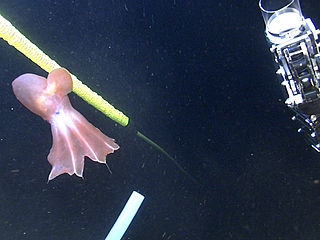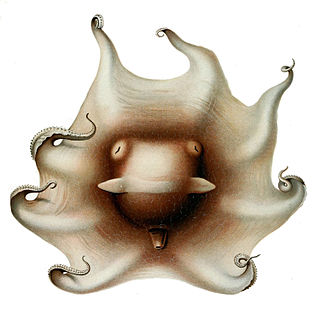
Cirroteuthidae is a family of pelagic cirrate octopuses comprising at least three species in two genera.

Grimpoteuthis is a genus of pelagic cirrate (finned) octopods known as the dumbo octopuses. The name "dumbo" originates from their resemblance to the title character of Disney's 1941 film Dumbo, having two prominent ear-like fins which extend from the mantle above each eye. There are 17 species recognized in the genus. Prey include crustaceans, bivalves, worms and copepods. The average life span of various Grimpoteuthis species is 3–5 years.

Umbrella octopuses are a group of pelagic octopuses. Umbrella octopuses are characterized by a web of skin between the arms, causing them to somewhat resemble an opened umbrella when the arms are spread.

Stauroteuthis is a genus of deepwater cirrate octopus, a cephalopod mollusk. This is the only genus in the family Stauroteuthidae, and only three species have been described in this genus.

Opisthoteuthis californiana, also known as the flapjack octopus, or flapjack devilfish is a species of umbrella octopus.

Cirrina or Cirrata is a suborder and one of the two main divisions of octopuses. Cirrate octopuses have a small, internal shell and two fins on their head, while their sister suborder Incirrina has neither. The fins of cirrate octopods are associated with a unique cartilage-like shell in a shell sac. In cross-section, the fins have distinct proximal and distal regions, both of which are covered by a thin surface sheath of muscle.

Cirroteuthis muelleri, also known as the big-finned jellyhead, was the first cirrate octopus species to be scientifically described. It is closely related to the genus Cirrothauma within the family Cirroteuthidae. At present the genus contains a single recognized species restricted to the Arctic Ocean and northern basins of the Atlantic and Pacific, but other species may be present in the southern hemisphere.

Cirrate octopuses possess a well-developed internal shell that supports their muscular swimming fins. This is in contrast to the more familiar, finless, incirrate octopuses, in which the shell remnant is either present as a pair of stylets or absent altogether.
Cryptoteuthis brevibracchiata, the short-arm flapjack octopod, is a deepwater species of octopod. It is the only species in the monotypic genus Cryptoteuthis one of the cirrate octopuses of the family Grimpoteuthidae, the umbrella octopuses. It is known from a single specimen which was collected in the northeastern Atlantic Ocean. It has characteristics which are shared with two other genera, Opisthoteuthis and Grimpoteuthis, but is sufficiently distinctive from either of these to warrant the erection of a new genus.

Opisthoteuthis is a genus of cirrate octopuses, sometimes known as flapjack octopuses, which are found in all the world's oceans.

Opisthoteuthis agassizii is a lesser-known, deep-sea octopus first described in 1883 by Addison E. Verrill.
Opisthoteuthis bruuni is a species of finned cirrate octopus found along the western coast of South America. Their tissue is almost jelly-like, and they have short, round bodies.

Opisthoteuthis extensa is a species of octopus found off the west coast of Sumatra, an Indonesian island. It lives at a recorded depth of 768 m (2,520 ft). O. extensa lives in a benthic habitat, like many other cirrate octopuses. It occupies a deep part of the ocean where little sunlight penetrates.

Opisthoteuthis grimaldii is an octopus found near the Azores.

Bathypolypus sponsalis, commonly called the globose octopus, is a deep sea cephalopod that can be found in both the eastern Atlantic Ocean and the Mediterranean Sea. It possesses many morphological traits adapted to a deep sea environment, including large eggs, reduced gills, no ink sac, and subgelatinous tissues. A distinguishing factor are the relatively large reproductive organs. Their diet consists of predominantly crustaceans and molluscs, but they sometimes consume fish as well. Bathypolypus sponsalis usually dies quickly after reproduction and only spawns once in their lifetime. Sexually mature females have a mantle length of at least 34 mm and sexually mature males have a mantle length of about 24 mm. Juveniles are white and transition to dark brown then to dark purple once maturity is reached.
Opisthoteuthis hardyi is a lesser-known octopus species. It was described in 2002 from a male caught off the Shag Rocks, which are far south in the Atlantic Ocean near the Falkland Islands.
Opisthoteuthis massyae is an octopus living in the eastern Atlantic Ocean.
Opisthoteuthis persephone is a cirrate octopus living south of Australia. In particular, it lives in waters off Tasmania, Victoria, New South Wales, and South Australia. The octopus has been found 270–540 m (885.8–1,771.7 ft) deep. It lives near and directly above the seafloor. S. Stillman Berry was the first to scientifically describe this species after capturing eight specimens while aboard the F.I.S. Endeavour in the early 1910s. In describing O. persephone, Berry called it an "exceedingly interesting octopod".
Opisthoteuthis philipii is an octopus of the Indian Ocean. It lives off the coast of Kerala, India. Known specimens were found between 275–365 m (902–1,198 ft) deep in the Arabian Sea near Alappuzha.
Opisthoteuthis robsoni, also known as the deep-water umbrella octopus, is a deep-sea octopus living off New Zealand on the Chatham Rise. It has been found from 1,178–1,723 m (3,865–5,653 ft) below the surface. Not much is known about the octopus' habitat or life cycle, as only four specimens have been found. It occupies the benthic zone, or the seafloor and the water directly above it. O. robsoni eats large amphipods.










